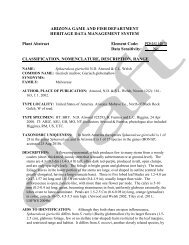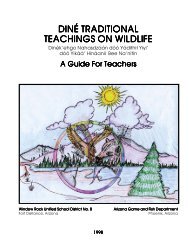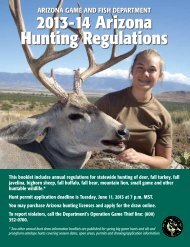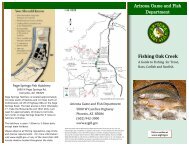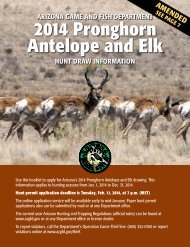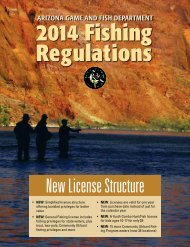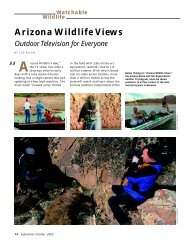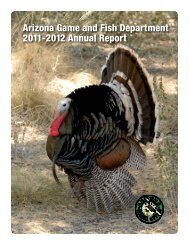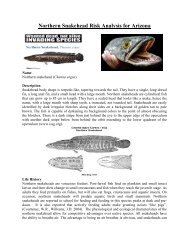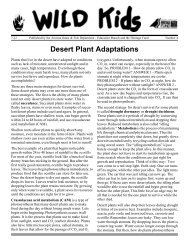ILF - Arizona Game and Fish Department
ILF - Arizona Game and Fish Department
ILF - Arizona Game and Fish Department
You also want an ePaper? Increase the reach of your titles
YUMPU automatically turns print PDFs into web optimized ePapers that Google loves.
10. Long Term Management Strategies<br />
The <strong>Department</strong> will assume responsibility for ensuring the long-term protection of each<br />
<strong>ILF</strong> project as a functioning aquatic resource. Adequate long-term financing mechanisms are<br />
an essential component for project success. One method is to include in the cost of each<br />
credit released an appropriately calculated percentage to build an endowment trust to provide<br />
income for long-term management <strong>and</strong> monitoring of mitigation projects. The Wildlife<br />
Contracts Branch is analyzing methods of long-term management funding, including<br />
methods of calculating annualized stewardship <strong>and</strong> organizational costs based on a<br />
software program by the Center for Natural L<strong>and</strong>s Management (Version 1.03 2007).<br />
11. Site Protection Requirements<br />
The type of ownership <strong>and</strong> long-term management strategy will vary by mitigation<br />
project site.<br />
The 2008 Rule, 33 C.F.R. 332.3(h) requires the project site to be permanently protected<br />
through an appropriate real estate or other legal instrument (e.g., easement, title transfer<br />
to state resource agency or l<strong>and</strong> trust).<br />
The Rule at 33 CFR 332.7 assumes that title ownership alone of a project site by a<br />
resource agency provides the necessary long-term site protection, based on the<br />
assumption that a resource agency or non-profit is committed to long-term protection of<br />
the project <strong>and</strong> would not act in a manner contrary to that interest. The <strong>Department</strong> is a<br />
state resource agency with statutory responsibility to manage <strong>and</strong> conserve <strong>Arizona</strong><br />
wildlife <strong>and</strong> wildlife habitat. That responsibility would include the management<br />
consistent with the terms <strong>and</strong> conditions of any mitigation <strong>and</strong> long-term management<br />
plan approved by the Corps in connection with a compensatory mitigation project<br />
situated on <strong>Department</strong>-owned property.<br />
Where an <strong>ILF</strong> mitigation project is or has been placed on <strong>Department</strong>-owned property, no<br />
additional recorded site protection measures are necessary. In the event the <strong>Department</strong><br />
proposes any incompatible change in use of <strong>Department</strong>-owned property set aside for<br />
compensatory mitigation, the <strong>Department</strong> will assume the responsibility to submit<br />
alternative compensatory mitigation proposals acceptable to the ACOE.<br />
For privately-owned l<strong>and</strong>s upon which an <strong>ILF</strong> mitigation project is proposed, the<br />
<strong>Department</strong>, as <strong>ILF</strong> sponsor, will draft <strong>and</strong> record a perpetual Deed of Conservation<br />
Easement in a form acceptable to Corps <strong>and</strong> thereafter monitor <strong>and</strong> enforce the deeded<br />
permanent site protections.<br />
<strong>Arizona</strong> Revised Statutes §§ 33-271 through 33-276 authorize the use of conservation<br />
easements to preserve <strong>Arizona</strong>’s natural ecosystems. The <strong>Department</strong> is qualified to act<br />
as a “holder” of a conservation easement pursuant to A.R.S. §§ 33-271 <strong>and</strong> is a<br />
“qualified organization” within the provisions of Sections 170(b)(1)(A)(v), 170(h) <strong>and</strong><br />
10



